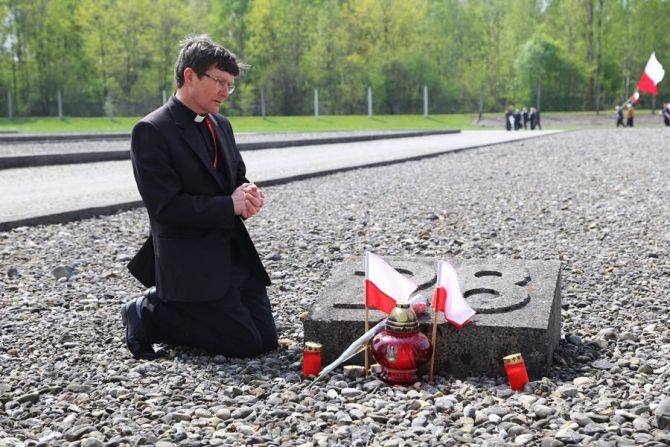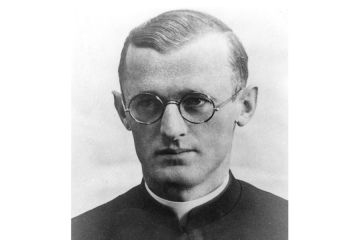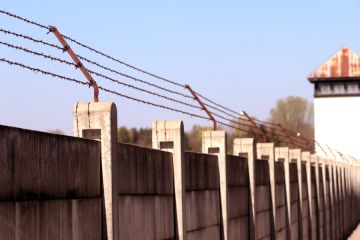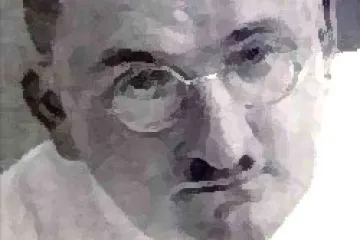CNA Staff, Apr 29, 2020 / 09:55 am
When the U.S. Army arrived at Dachau concentration camp 75 years ago, on April 29, 1945, the clergy held captive there regarded it as a miracle.
A week earlier, on April 22, the priests and monks of Dachau had consecrated themselves to St. Joseph, fearing that the guards were planning to murder them before fleeing the advancing Allies. If they were spared, they promised they would make an annual pilgrimage to St. Joseph's Shrine in Kalisz, central Poland.
In fact, they were going to be executed. But two hours before they were due to be killed at the camp -- once described as "the largest priest cemetery in the world" -- a small U.S. Army patrol unit arrived and saved them.
That is the story told by Bishop Edward Janiak of Kalisz in a message marking the Day of Martyrdom of the Polish Clergy, which commemorates the hundreds of priests and religious killed at Dachau and elsewhere. It is observed April 29.
"As it happened unexpectedly, two hours before the liquidation of the camp and several hours before the attack on KL [Konzentrationslager, or concentration camp] Dachau planned by the American command, the fact of the earlier liberation of the camp was considered by the prisoners as a special grace received from God through the intercession of St. Joseph of Kalisz," Bishop Janiak wrote in the message dated April 20.
Among the camp's liberators was Leonard Bachmann, an 18-year-old mortarman from St. Paul-Minneapolis. Moved by the suffering he witnessed, the Bronze Star recipient entered the Missionary Servants of the Most Holy Trinity in 1948 and was ordained a priest. He served as pastor of parishes in Colonial Beach and Kilmarnock, Va., and director of a shrine in Stirling, N.J, dying in 2000.
The Nazis established Dachau, near Munich in southern Germany, as their first concentration camp in 1933. Over the next 12 years, 2,794 Catholic clergy were sent there, the majority from Poland. They were housed with a smaller number of Protestant, Greek Orthodox, Old Catholic, Mariavite and Muslim clerics in a section known as the Priest Barracks.
Notable prisoners included the German Lutheran pastor Martin Niemöller, who survived the camp, Dutch Carmelite Titus Brandsma, who died of a lethal injection in 1942, and the Italian Dominican priest Blessed Giuseppe Girotti, who died shortly before the camp's liberation in 1945, probably also by lethal injection.
Also among the prisoners was Fr. Engelmar Unzeitig, a priest with Czech roots dubbed the "Angel of Dachau" because of his ministry to fellow prisoners. He volunteered to care for the sick in the typhoid barracks, bathing them, praying with them and offering them last rites. He succumbed to typhoid fever on March 2, 1945. Pope Francis officially recognized him as a martyr in 2016.
Only 818 of the 1,773 Polish clergy sent to Dachau survived until the camp's liberation. Many were subjected to medical experiments, being exposed to malaria or given infections. Among the victims was Kazimierz Majdański, who survived to become the post-war archbishop of Szczecin-Kamień.
When Pope John Paul II beatified 108 Polish martyrs of World War II in 1999, there were 43 Dachau inmates among them.
One of them was Blessed Franciszek Drzewiecki, an Orionine Father, who refused to be exempted from hard labor at Dachau. While he tilled the soil, suffering from frostbite and malnutrition, he secretly adored consecrated hosts that he kept with him in a small box. When he was sent away to be gassed in 1942, he said to his companions: "We offer our life for God, for the Church and for our country."
One in five of Poland's diocesan priests died in the Second World War, according to Fr. Paweł Rytel-Andrianik, spokesman for the Polish bishops' conference. The Nazis killed an estimated 2,000 diocesan priests, 370 friars, and 280 nuns. In addition, about 4,000 priests and monks, and more than a thousand nuns were sent to camps.
"There were dioceses such as Włocławek, Gniezno, and Chełmno, where almost every second priest was murdered," Fr. Rytel-Andrianik said.
"Four Polish bishops were also killed in the camps, and nearly half of the Roman Catholic dioceses were deprived of the bishops who were at the head. Consequently, it can be said that it was not only a war against the Polish state and the Polish people, but also against the Catholic Church."
After the war, the clergy who survived Dachau fulfilled their vow, making a pilgrimage to Kalisz every year on April 29. In 1970, they founded a Chapel of Martyrdom and Gratitude in the crypt of St. Joseph's Shrine. At the chapel entrance, there is a representation of a barbed wire fence and a plaque thanking St. Joseph "for liberation from the abyss of death."
Poland's bishops established April 29 as the Day of Martyrdom of the Polish Clergy in 2002 as a way of continuing the survivors' annual act of thanksgiving. Fr. Leon Stepniak, the last surviving Polish priest imprisoned at Dachau, died in 2013.
(Story continues below)
Mass was celebrated in the Chapel of Martyrdom and Gratitude at noon local time April 29, marking both the 75th anniversary of Dachau's liberation and the 50th anniversary of the chapel's foundation.
In the decades following the war, the Polish and German bishops emphasized healing and forgiveness. In 1965, Poland's bishops sent a historic pastoral letter to their German counterparts calling for reconciliation between Poles and Germans. The letter was strongly supported by Karol Wojtyła, then archbishop of Kraków and the future Pope John Paul II.
Celebrating Mass at Dachau in 1995, German Cardinal Friedrich Wetter said: "Even when we see no grave around us, we are standing on the largest priest cemetery in the world."
He paid tribute to Polish clergy killed in the camp, saying that "Poles made the biggest sacrifice."
Germany's bishops issued a 23-page document April 29, examining their predecessors' actions during the war. They argued the wartime German bishops were complicit in the conflict because "they did not offer a clear 'no' to the war."
In a statement April 29 marking the 75th anniversary of Dachau's liberation and the Day of Martyrdom of the Polish Clergy, Archbishop Stanisław Gądecki called for prayers for those who had experienced suffering.
"May it be an expression of our memory, honor and solidarity towards the martyrs and a prayer to God for peace and reconciliation for all," the president of the Polish bishops' conference said.
This article has been corrected to reflect the fact that Fr. Leon Stepniak was not the last surviving Dachau prisoner, but rather the last surviving Polish priest imprisoned in the camp. The last surviving priest was the German Fr. Hermann Scheipers, who died in 2016.





